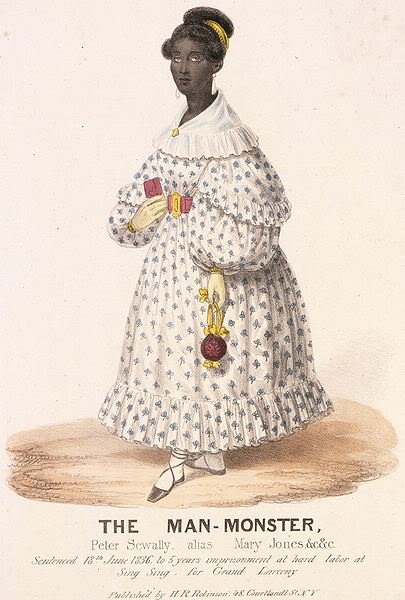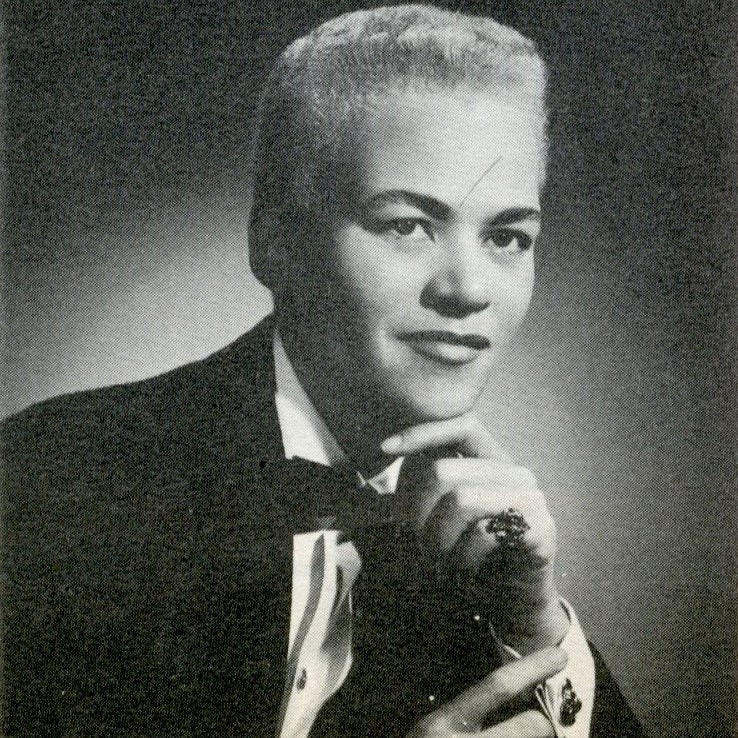
Peter Sewally (Mary Jones)
Peter Sewally was born on December 12, 1803 (date of death unknown). Sewally, dubbed the “Man-Monster,” was a New York City prostitute and pickpocket who wore women’s clothing and went by the name of Mary Jones. Sewally was convicted of grand larceny during a sensational 1836 trial that gave observers of the era one of the earliest recorded insights into men who dressed as women, and men who had sex with men.
Although the few biographies that have been written about Peter Sewally/Mary Jones generalize a birthdate as 1803 with no month or day, Sewally was recorded in a legal affidavit from June of 1836 as stating, “I will be thirty three Years of age on the 12th day of December next, was born in this City [New York]…” Information about Sewally’s childhood and young adult years are lost to history, but newspaper accounts during his trial implied that Sewally had been a prostitute for some time as an adult, and served in “State service,” or the military.
“Sewally has for a long time past been doing a fair business, both in money making, and practical amalgamation, under the cognomen of Mary Jones,” declared the New York Herald on June 17, 1836. The term “amalgamation” was used often at the time to refer to sexual relations between people of different races. The New York Sun added, “During the daytime, Sewally generally promenades the street, dressed in a dashing suit of male apparel, and at night prowls about the five points and other similar parts of the city, in the disguise of a female, for the purpose of enticing men into the dens of prostitution, where he picks their pockets if practicable, an art in which he is a great adept.”
Sewally’s relative life of obscurity came to an end on June 11, 1836, when a white man, Robert Haslem, met a Black woman named Mary Jones on Bleecker Street in Manhattan. According to published reports, Jones was dressed “elegantly and in perfect style” with white earrings and a gilt comb in her hair. Following a conversation, Jones and Haslem went to an alley off Greene Street and proceeded to get intimate.
On his way home, Haslem discovered that his wallet had been stolen, along with nearly a hundred dollars. Another man’s wallet, with a bank order for $200, had been placed on Haslem’s person. The man initially denied owning the wallet when Haslem tracked him down, but later admitted that he had been pickpocketed by Mary Jones. Afraid to expose his activities, the man did not call police to report the crime.
Haslem, however, was intent on pressing charges, and went to the authorities the following morning. While searching for Mary Jones, a constable (police officer) passed a Black woman on the Bowery, and asked, “Where are you going at this time of night?” Jones replied, “I am going home, will you go, too?” The constable went with Jones to a nearby alley, where she “proceeded to be very affectionate.” Jones was placed under arrest, but resisted—getting into a “tussle” and allegedly tossing two wallets, including Haslem’s. After Jones was locked up, police found several other wallets in her apartment.
Charged with grand larceny, Sewally went to trial on June 16, 1836. He arrived at court “neatly dressed in female attire, and his head covered with a female wig,” reported the New York Sun. Whether Sewally chose to dress that way or had been forced is unknown. What is documented is that the proceedings turned into an opportunity to ridicule Sewally, with spectators and court officials laughing at his expense and, at one point, a courtroom observer removed Sewally’s wig.
From records collected during Sewally’s arrest and subsequent trial, we learn that he began to dress in women’s clothes while “…in the practice of waiting upon Girls of ill fame and made up their Beds and received the Company at the door and received the money for Rooms &c [an abbreviation of et cetera or etc.] and they induced me to dress in Women’s Clothes, saying I looked so much better in them and I have always attended parties among the people of my own Colour dressed in this way—and in New Orleans I always dressed in this way…”
The arresting constable also claimed that Sewally attempted to pass as a biological woman by fitting himself with a piece of “cow” (presumably slabs of meat, which led to Sewally being called “Beefsteak Pete”), cut open to resemble a vagina and held up by a girdle. It remains unclear whether Haslem and Sewally’s other clients failed to realize that Mary Jones was a man, didn’t care, or were aware but afraid to admit that they enjoyed her company.
Sewally denied ever seeing Haslem and stealing his wallet, but the jury saw it differently. After deliberating for a short time, the panel convicted Sewally of grand larceny, and he was sentenced to five years in Sing Sing prison. Because Sewally never had anal intercourse with Haslem (or Haslem did not want that made public), he was not charged with sodomy.
Following Sewally’s release from prison (presumably around 1841), very little is known about the remainder of his life, with the exception of two published reports that appear to refer to “Beefsteak Pete.” On August 9, 1845, the New York City-based Commercial Advertiser reported that “a notorious character, known as Beefsteak Pete, was arrested on Thursday night, perambulating the streets in woman’s attire.”
On February 15, 1846, the New York Herald published a story about “Pete Sevanley [sic], alias ‘beef steak Pete’; a notorious black rascal, who dresses in female attire and parades about the street.” The piece referred to Pete being released the previous Sunday from Blackwell’s Island (at the time the site of a “lunatic” asylum, later renamed Roosevelt Island), and being arrested for “playing up his old game, sailing along the street in the full rig of a female.” He was reportedly sent back to prison for six months.
Besides the sensational life story he left behind, Sewally’s legacy was made permanent in a lithograph of him dressed as a woman with the words: The Man-Monster; Peter Sewally, alias Mary Jones, &c&c; Sentenced 18th June 1836 to five years imprisonment at hard labor at Sing Sing for Grand Larceny. There is debate to this day about whether the term “monster” applied to Sewally being Black, engaging in prostitution, dressing as a woman, or a combination of the three.
In the book “The Amalgamation Waltz,” Professor Tavia Nyong’o surmised that it was because of Sewally’s testimony and defense of the way he presented that “the queer subject transforms shame and stigma not by transcending them or repressing them but by employing them as resources in the production of new modes of meaning and being.”
We remember Peter Sewally aka Mary Jones for adding an interesting, important, and relatively unknown chapter to LGBTQ and African American history.
Source material: Jonathan Ned Katz, Love Stories: Sex Between Men Before Homosexuality [Chicago University Press, 2003].


